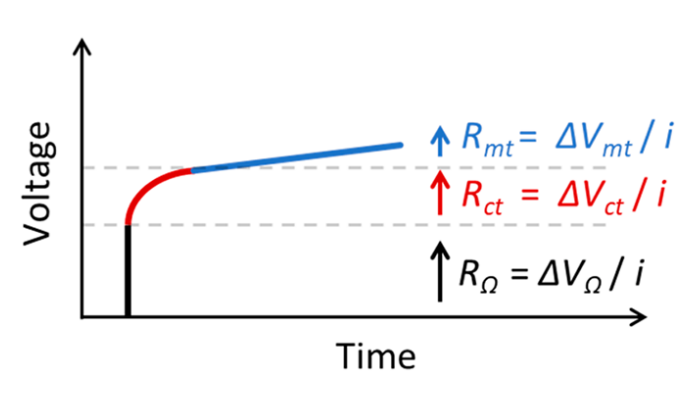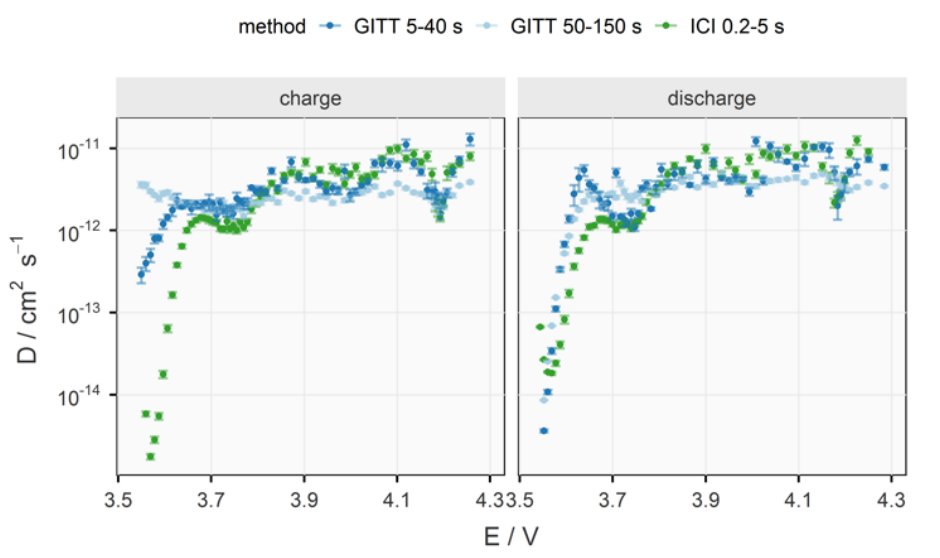Reinventing the DCIR wheel
There is a new paper out comparing AC & DC methods for resistance determination in batteries which frustrates me, for several reasons. Some of these reasons are purely self-centred but others I think reflect many problems with publishing today.
I’ll get (some) selfish reasons out of the way first. The paper compares resistance measurements made by constant current pulses and by AC signals (EIS) for polymer electrolyte-based batteries and finds them to be similar.
I’ve been working on this topic for 8 years, specifically the “intermittent current interruption” approach (a DC method conceptually the same as galvanostatic pulse), w/ several publications explicitly validating the method against EIS, including on a theoretical basis, also including 2 papers studying polymer electrolyte-based batteries. None of my work is cited despite the very strong relevance. I can cope with that, there’s a lot of literature out there.
But reading this paper, one could get the impression that DC resistance measurements are an overlooked technique which no-one thinks to use, when in reality it is the standard technique in the battery industry.
There doesn’t seem to be any cited literature on using DCIR, and I can’t distinguish the method in this paper from conventional DCIR except for dividing the potential response into three regions corresponding to major processes (ohmic, charge transfer, mass transport). I then take issue with the conclusion of the paper that the DC and AC methods “reveal even similar values” for these major processes. Why would we expect otherwise? If you have a system you can model with an equivalent circuit (not done here) why shouldn’t the methods be capable of giving you exactly the same result?
(One of) the historical problem(s) in connecting DCIR and EIS is that DCIR tends to look at the magnitude of voltage changes at arbitrary times, making the resistances somewhat time dependent.

You can deal with this by fitting to an equivalent circuit model but this hasn’t been done here. In fact there is a rather questionable simplification where the capacitive contribution is just ignored so long as it doesn’t contribute too much (Fig S1). That might work for this system with a high ohmic contribution, but what about other systems?
These are questions which the research I have done on “ICI” has focused on for several years, through careful simplification of the system and the theoretical basis. In our (my and Yu-Chuan Chiens) approach we simplify to fitting the mass transport-controlled region to get two quantities, “R” (ohmic + ‘charge transfer’) + “k” (mass transport). Unlike the paper under scrutiny here, both have the important characteristic of being, in theory, both independent of current and time. And, under ideal conditions, you get identical values from EIS (see e.g. this paper.
This technique works and we have used it in a number of studies on Li-S batteries, Li-ion batteries (including commercial cells), Na-ion batteries, in combination with in situ/operando studies (v. useful). I think this is a good demonstration of the value of DC-based methods.
But there’s more - in two recent studies (one in pre-print), we have shown that we can extend the analytical treatment so that (with care) we can determine diffusion coefficients from ICI measurements in a matter of seconds.

This for me a good demonstration of what is possible with a short-duration DC pulse.
Which brings me onto my last point: we first submitted the above pre-print to Chem. Mater. because we thought an easy technique that could add an extra dimension to in situ/operando studies without the burden of interpretation and slowness of EIS would be very interesting to materials chemists. But it was rejected after review as being out of journal scope, specifically because we considered the theoretical basis, derived the equations for the technique we proposed, described limitations and shared the code - therefore it should be in a specialised journal only..?
So it is frustrating to see the same journal publish a paper with a very similar aim, but a much less useful method, not least because it is unclear how some of the quantities are even calculated (e.g., “some milliseconds”). It is also frustrating to see this journal, and these authors, which I otherwise have a high opinion of, publish this also considering that 21/35 references are self-citations, which should raise eyebrows for a topic with a very rich selection of existing literature.
So I’m going to round off this long thread with a few general requests to anyone who is still reading:
1) Authors: please make every effort to read cite the primary literature, even if you arrived at some aspects independently - something similar has almost certainly been done before. I really tried hard to look for previous reports of ICI or similar methods before I published.
2) Senior authors/PIs: give credit to junior researchers and/or smaller groups where credit is due. I have seen and experienced senior profs presenting concepts as their own when key work was done by less well known researchers and it’s not cool. Yu-Chuan Chien deserves a very large slice of the credit for developing the analytical basis of ICI and turning it into a genuinely useful technique that is used by a few research groups now and even a couple of companies.
3) Reviewers: just because an interdisciplinary paper has technical stuff from a different area you aren’t familiar with, doesn’t mean it should be in a specialised journal in that field. Just b/c a technique has limitations (all do) doesn’t mean it has no real application.
4) Editors: I know you do a really difficult job and there is no way to make the peer review process fully fair. But I’m sure we can do better than this and I think a bit more dialogue with authors where possible would help. I hope.
comments powered by Disqus